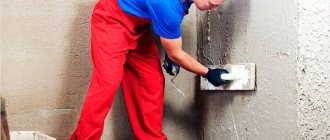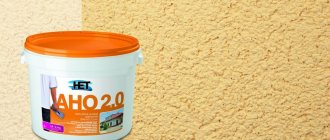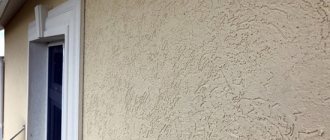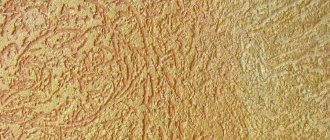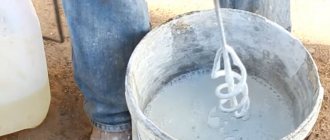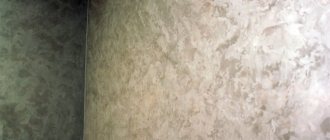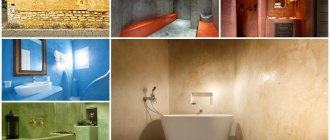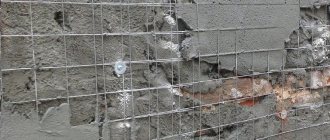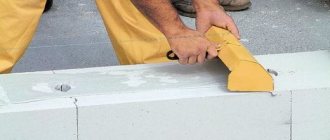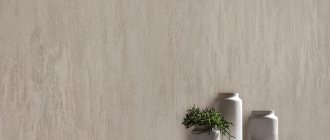In some cases, for finishing, in addition to decorative and leveling plaster solutions, special ones are required that perform specific functions. These include barite plaster, designed to protect personnel in rooms adjacent to the X-ray room from radiation. What it is, its advantages, calculation methods and application technique are discussed in this article.
Scope of application
Due to the use in some institutions and industries of technical equipment that is a source of radioactive radiation, barite plaster is used:
- at industrial enterprises for premises where radioactive substances and materials are used in production processes;
- in laboratories and research centers where technology emitting gamma rays is used or radioactive materials are studied;
- in tomography and x-ray rooms, where equipment generating ionizing radiation (IR) is used;
- in dental clinics where dental photographs are taken;
- in residential buildings located where the natural level of radiation is unfavorable, or located in industrial areas with an increased level of radiation (in this case, it is necessary to install a protective coating over a layer containing barite);
- in sarcophagi and storage facilities for radio emission sources.
Scope of application of barite plaster
To shield X-ray and gamma radiation, expensive lead shields were previously used.
An alternative to lead protection has become X-ray protective plaster, the magnitude of the shielding effect of which depends on the proportions of the composition and thickness of the coating. An alternative to barite plaster coating is barite slabs.
Properties and Application
The physical properties of barite plaster are actually similar to other mixtures. But there is one important point that you should pay attention to.
Plastering walls with barite mixture protects them from harmful x-rays and gamma rays. The secret of the protective properties of the composition lies in the use of a mineral ingredient: barite sand, which in its chemical composition is granulated coarse-grained barium sulfate salt.
Its particle size is within 1.25 mm. When plastering X-ray rooms, barium plaster is prepared using high grade cement:
- M300.
- M400.
- M500.
note!
The cladding of the walls of medical institutions
may suffer (cracks will appear and begin to crumble) if low-quality cement is used
.
Components of barite plaster
The main substance that gives the coating the ability to reflect gamma rays and x-rays (XR) is barite sand. The mineral component (sulfate salt BaSO4) in the form of sand, granules (fraction up to 1.25) can constitute up to 95% of the solution (at least 85% by weight in the dry mixture). The size of the fractions depends on the required thickness of the coating - the thicker the layer, the larger the grain size barite sand can have.
Barite dust is used very rarely due to its harmfulness; it is most often used to shield residential premises from natural background radiation. The substance is toxic, therefore, when applying the coating, protective agents are used to prevent dust from entering the respiratory tract, and a layer of ordinary or decorative plaster is applied on top of the protective coating.
Barite sand is white in color and has a specific gravity of 4.48 kg/cm3, which explains the higher weight of the X-ray protective composition compared to other plasters.
The binder in the solutions is high-quality cement (not lower than M300), since barite sand adheres less reliably to low-grade cement. In the latter case, the mixture crumbles, crumbling even when laid. The compositions harden slower than mixtures made with ordinary sand. If it is necessary to accelerate hardening, and the water resistance of the coating does not matter, use magnesia cement.
Thus, X-ray protective compounds are:
- cement-barite;
- magnesium-barite;
- barite concrete.
Polymers or other plasticizers are added to the composition to increase the working properties of the mixture - plasticity, workability. When making the composition with your own hands, use PVA less than 3% of the weight of the SS (per 1 kg of mixture - 30 g of glue).
Factory SS is diluted as follows - 200 ml of water per 1 kg of powder. The mixture, compiled independently, is diluted gradually, bringing to the desired consistency by adding liquid.
Selection criteria and best manufacturers
Often, ready-made solutions contain M300-M500 Portland cement. But if it is required that the material hardens in a short period of time, and the low index of the finished mixture is not important, then materials with magnesium cement are used.
Construction stores provide a list of ready-made solutions.
- SOREL BARIT M150 is a magnesia binder material, the product contains barite concentrate, various additives of mineral and polymer origin, which are determined by the required operational requirements. The cost of 20 kg of mixture is 1200 rubles, including 5 liters of mixer.
- FullMIX barite plaster, Rosi - a finishing composition for protection against radiation, RUNIT - the composition contains barite and plasticizers, the base of the mixture is cement-binder. The cost of the solution for 25 kg is from 670 to 780 rubles.
- ALFAPOL ST-BARITE is a magnesium barite product costing from 850 rubles. for 25 kg.
In addition to the finished material, you can buy KB-3 class B material costing from 7,700 rubles, class A from 13,000 rubles. per ton, and then make your own plaster solution with the required ratio of components.
X-ray protective barite plaster fullmix is presented as a dry construction product, the main element of which is cement, ground barite concentrate, modified polymer additives that increase protection and strength, improve adhesion to walls.
Fullmix barite plaster mortar is durable, pliable, and has high adhesion. Due to its physical properties, the material is able to contain gamma and x-ray radiation. The material is environmentally friendly and easy to decorate.
It is used to protect the construction of storage facilities for radioisotope accumulations from radiation, since the solution can replace expensive lead defense. Due to the chemical passivity of barite, the material can also be used to decorate walls at home, under coating with finishing mixtures.
Manufacturers and characteristics of ready-made mixtures
The number of manufacturers of materials containing barite is not as large as manufacturers of other types of plaster compositions.
The main ones are:
- Alphapol.
- Aksit.
- Flagship.
- Reference.
- Sorel.
- Roshi.
- Barite concrete.
- Runit.
More often, batches of ready-made SS barite concrete are produced for individual orders.
Dry mixtures offered by manufacturers differ in composition, properties, and price:
- Sorelbarit - contains a magnesium binder, barite chips, plasticizers (sold as a two-component material - CC + hardener), reinforcement due to basalt fibers, application of a layer of up to 3 cm per pass is allowed.
- FullMIX – M400 cement, barite chips, plasticizers, per pass – up to 10 mm.
- Radiation protection Russia.
- Runit.
- Alfapol SHT-Barite – barite crumbs with magnesia
Rules for choosing plaster
According to the standards, the layer of barite solution should be equal to 10.5 mm, which in terms of shielding properties is equivalent to 1 mm of lead. There are two main types of barite solutions:
- magnesium-barite;
- cement-barite.
FullMix barite plaster from the Runit brand is one of the most popular mixtures. It is characterized by low cost and high quality X-ray protective components. More details about the mixtures and their differences can be found in the table below:
| Mixture: | Description: |
| Alfapol SHT-Barit | Dry magnesia-barite mixture |
| SOREL BARIT M150 | It contains magnesium binder, polymer and mineral additives and barite concentrate. |
| ROSI, RUNIT, FullMix | Cement base, barium sulfite and plasticizers as a binder |
Barite solution is quite problematic to find in construction hypermarkets. Most often it is produced to order in the required quantities. In addition, the master can independently prepare a barite mixture from KB-3 class B barite with proper selection of the number of components.
X-ray protective homemade plaster has specified shielding properties, but it is quite difficult to apply such a mixture and evenly distribute the components for good radiation protection. The price per kg of barite plaster depends on the manufacturer and the components that make up the solution. As an alternative, special barite concrete slabs are also suitable for cladding the walls of the room.
Advantages of barite plaster
Main advantages:
- the ability to screen different types of AI;
- low cost of coverage;
- availability of components on the market;
- ease of application;
- solidity of the coating;
- possibility of making it yourself;
Almost all of the disadvantages are easily overcome:
- with a large thickness of the protective layer, additional preparation will be required (production of formwork);
- toxicity of the main component;
- high specific gravity of the coating;
- manual application only (mechanical excluded);
- the need to install reinforcing mesh;
- the need for additional coating of a layer with barite;
- Each previous plaster layer is primed to increase adhesion.
Calculation of the required amount of material
The calculation of the material that will be required for plastering the walls in a particular room is carried out based on how many layers the material will be applied. To do this, you need to know the exact thickness of the layer. The whole problem is that, despite the generally accepted standard for making barite plaster, different manufacturers use different proportions of components.
This is where the technical documentation that manufacturers supply along with their mixtures comes to the rescue. It contains a description of how to correctly calculate the amount of material for a room.
How to prepare barite plaster
You can prepare a protective composition at home yourself. Fortunately, all components (including barite sand) are available in stores.
However, it should be borne in mind that home-prepared/made X-ray protective compounds have disadvantages:
- the consumption of materials will be large, and there will be a lot of waste;
- the protective properties will not be the same across the entire plane of the wall;
- difficulty in caring for each layer, and the technology must be followed, following each point of the instructions, otherwise cracks or peeling will appear;
- making the solution, applying the coating, and caring for each layer takes a lot of time.
There are few advantages:
- low cost;
- possibility of self-production from available materials.
If possible, it is more rational to purchase ready-made formulations that just need to be mixed before use.
Certificates are not issued for homemade protective plaster. For a ton of solution with a density of 2700 kg/cm3 take:
- Portland cement – 60 kg;
- barite (dust, sand) – 800 kg;
- regular sand – 55 kg;
- PVA glue – 5.5 liters;
- water in the amount necessary to create the desired consistency (per 1 kg of cement no more than 0.9 l).
Composition of components for preparing barite plaster
If calculations show that the layer should be more than 50 mm, it is more rational to use a barite plate for protection. Dry components (barite sand and others) are mixed, then added to water in which PVA is dissolved.
The procedure for preparing a mixture of barite concrete m200
The protective mixture is used for:
- pouring floors;
- production of blocks for laying partitions and production of protective fences for X-ray equipment;
- performing a protective coating using formwork;
- plastering works.
The barite concrete mixture goes on sale in the form of two components:
- liquid hardener;
- barite concrete powder, which contains polymers.
The components are placed in a concrete mixer container and mixed by adding water. The amount of water depends on the purpose of the solution. The solution is made thinner for plastering, and thicker for floors and walls.
The prepared mixture is used for 45 minutes before the start of polymerization, so the amount of concrete and the workers involved in laying it is determined in advance.
What is barite plaster and why is it needed?
Finishing barite material is a dry material made:
- from high grade cement used as a binder component;
- barite sand (barium sulfate concentrate) - a filler that replaces sand in simple cement plasters;
- various plasticizers that determine the properties of the material at the stage of its preparation.
The ability to retain X-ray radiation, the material is due to the presence of barite. The choice to use such mixtures is determined only by economic considerations, since the barite solution has a low cost relative to lead sheets. For this reason, in X-ray rooms and other rooms used for X-ray equipment, the walls are plastered with a barite mixture.
The presence of sodium sulfate in the composition should not be alarming. The concentrate, which is used in production according to GOST 4682-84, may contain about 95% of it, the remainder being silica sand. The only danger to humans is the dust of these elements. In case of prolonged exposure, dust can cause lung disease.
Requirements of sanitary authorities for the application of barite plaster
X-ray protective plaster is a special composition that protects the health of people in the room with the equipment and in those adjacent to it, therefore, according to SanPin 2.6.1.1192–03, it is subject to certain requirements that it must meet.
Firstly, during design, the thickness of the protective lead screen is calculated and taken according to the coefficient of attenuation of radiation radiation at the maximum power of the equipment beams. According to this thickness, the thickness of the protective plaster layer with barite is determined. Approximate data are given in the table.
Since protective mixtures of different modifications differ, an individual approach is needed in each case. For example, at a voltage of 100 kW at the anode of the emitter, the lead equivalent thickness of magnesia-barite plaster in the X-ray room is:
The parameters of the lead shield are specified in the project. If the equipment used changes, recalculation is carried out. Any changes must be agreed with the supervisory organization. According to the requirements of GOST 12.4.217–2001, tests are carried out for each batch of protective mixtures (in production) and for laid plaster coatings, information about which and the results are recorded in protocols.
Making your own plaster
To make barite plaster, you will need:
- Barite concentrate in granules no more than 1.25 mm. If the radiation background does not exceed the natural value, the use of barite dust is allowed.
- Cement . The material must be of high quality, since barite does not adhere to a low-quality composition. As a result, the coating quickly crumbles and cracks.
- Plasticizer (for example, PVA construction adhesive). This component increases the viscosity and level of adhesion of the solution.
Barium is taken at the rate of 850 g of component per 1 kg of the finished mixture . The volume of plasticizer is determined during stirring to obtain a solution of the required viscosity.
Valera
The voice of the construction guru
Ask a Question
The powdered compositions are mixed dry, and the glue and water are diluted in another container. For 1 kg of dry mixture, 250 ml of liquid components are needed, but this figure varies depending on the absorbency of the cement and the temperature of the room. The mixed dry powder is added to water and stirred with a construction mixer, bringing the mass to a homogeneous state. When mixed correctly, X-ray protective plaster adheres well to the surface and does not flow off the spatula.
Technology of plastering with barite plaster
In general, the process is carried out in several stages:
- preparation of the base;
- installation of reinforcing mesh;
- installation of special beacons that allow the solution to be applied evenly to the entire surface, or formwork;
- plastering;
- maintenance of installed finishes;
- finishing coating.
Such features of the coating with barite, such as high specific gravity and high cost, require saving the solution and ensuring the strength of its adhesion to the base, so the preparation of the base is carried out especially carefully:
- remove all old coatings;
- repair potholes and large cracks;
- After cleaning from oil stains, fungus, grease, removing unnecessary metal products and dust, the base is primed twice, drying each layer.
After the primer has dried, the walls are measured. Determine the thickness of the coating and calculate the required amount of materials.
Barite X-ray protective plaster is applied:
- manually;
- at a temperature of +15 - +35°C,
- at humidity up to 75%,
- layers no more than 10 mm.
The place of plastering work is shaded and protected from precipitation.
Plastering walls
To obtain a high-strength coating, reinforcement is used. The mesh is attached to the base with screws or dowels. When installing and fastening the mesh, stretch it as much as possible, avoiding sagging. Every 15 mm of the thickness of the X-ray protective composition must be reinforced.
Main stages of plastering:
- Apply a starting layer of 10 mm evenly onto the base using a wide spatula. Having applied a layer, “line” the surface with the corner of a spatula to increase its adhesion to the next one. Dry, cover with a primer, which is dried for 3 - 4 hours.
- Perform a second layer of 5 mm (all subsequent layers will be the same thickness). After partial hardening, a second reinforcing network is attached to the wall.
- Further layer-by-layer application of the solution is carried out, reinforcing and drying in time, until the coating reaches the specified value.
The finish is dried until it gains strength for at least 7 days, ensuring that the surface remains moist (covered with film) to prevent the formation of shrinkage cracks.
Technology of work execution
The work depends on the thickness of the plaster, and is calculated at the design stage in accordance with the expected radiation exposure. Barite plaster is applied in a thick layer, so careful preparation of the base is an important condition for reliable adhesion. Before starting work, it is necessary to remove the coating, trim, and remove nails, screws, and self-tapping screws. Then tap the walls, ceiling and floor to identify loose elements and remove them. Ideally, the result should be a flat wall. If cracks and potholes appear on the surface, they must be repaired with cement-sand mortar.
Main stages
The process of applying plaster consists of several stages:
- Primer. After preparation, to improve the adhesion of the solution to the base, it must be treated with a special compound - a primer.
- Reinforcement of surfaces with mesh. If the project provides for the application of multi-layer barite plaster, then a plaster mesh is installed to increase strength and prevent crumbling. It must be installed every 15 mm of the mortar thickness. The mesh structure is fastened with screws or nails at intervals of 50 cm from each other, and is stretched well, preventing sagging.
- Applying the first layer. It should be no more than 1 cm thick. Stripes are drawn on a damp surface with a spatula to improve the adhesion of the plaster layers.
- Primer. The plaster is allowed to dry and then treated with a primer. After 2 hours you can start making the second layer.
- Second layer. Thickness no more than 5 mm. Be sure to dry the layer well (the drying time of the solution is indicated in the manufacturer's instructions).
- Installation of plaster mesh. Stuffed similarly to step 2.
- The following layers are performed with periodic reinforcement and priming of surfaces. After reaching the design thickness, the plaster should dry out and gain strength within a week.
- Grinding. Before decorative finishing, the surface must be sanded. Due to the toxicity of barite dust, work must be performed in a respirator.
- Decorative finishing. Serves to add aesthetics to the room, as well as to prevent barite dust from entering the air. Oil paint, wallpaper, plastic panels and other finishing materials are used.
Features of applying plaster
When performing barite plaster, the application technology has the following features:
- work is carried out at room temperature +15…+35°C and humidity 75%;
- plastering is done manually, without the use of special equipment;
- the prepared solution must be used within 45 minutes, otherwise it will lose its technological properties;
- the maximum layer thickness is 10 mm; if you deviate from this rule, the drying time and strength gain of the solution increases;
- to control the uniformity of layer thickness, you can use plaster beacons;
- the minimum layer when finishing partitions and floors is 30 mm, and for ceiling panels - 50 mm;
- in ceilings, the barite composition is introduced into adjacent rooms by 2 cm.
Finishing the walls
After gaining strength, the surface is sanded with sandpaper or a grinder (protecting the respiratory tract with a respirator). In addition to decorative functions, the finishing serves the purpose of protecting the room from barite dust entering the air. Wallpapering, thin-layer decorative plaster, painting, and plastic panels are used as finishing materials.
Technology of pouring barite plaster in a thick layer
When the thickness of the barite plaster finish is > 2 cm, the application technology using formwork allows the work to be completed faster, better and more reliably. Formwork panels are made from sheet plywood or boards. The installation of formwork is preceded by the installation of reinforcing mesh. In this case, the height of the caps of the fastening elements is taken equal to the total thickness of the coating, in other cases - close to the height of the mesh installation.
Board formwork
To fill the plaster coating of the wall, you can make panel formwork from boards (edged) about 20 mm thick.
Manufacturing sequence:
- Measure the wall to calculate the dimensions of the formwork panels. If the length of the wall is up to 3 m, you can make one long shield. If the wall length is 3 meters or more, two panels are made, for example, one and a half meters long. The rational height of the shield is up to 100 cm.
- 30 x 50 mm slats are used as vertical stiffeners, installing them no further than a meter from each other. Attach the slats, pressing the boards tightly against each other. For pressing, stops and wedges are used. Diagonal slats are added to the vertical slats to give rigidity to the shield.
- After assembling the shield, the formwork is turned over with the front (working) side up to check the formed plane. If the boards do not form a single, even plane, they are unfastened and, after correcting the position, fixed again.
- The manufactured shield(s) are installed against the wall, resting on the dowels to which the mesh is attached. Check verticality with a level.
- Fix the position using corner supports.
- The plaster solution is poured into the formwork from above, making sure that it fills the cavity evenly. It is advisable to use vibrators. If they are absent, tap the formwork boards with hammers from the outside. This is how the air bubbles formed during pouring are “expelled.” This is done until the settling of the poured mixture stops.
- The formwork panels are removed when the poured mixture has hardened (not earlier than in a week). Doing this earlier is risky, as peeling or cracks may occur. The removed formwork panels are raised higher and fixed. Then the next section is filled with barite composition.
- The very top of the wall is plastered by hand, applying layers with a trowel or spatula.
- The resulting protrusions of the solution are rubbed or chipped off.
Floor protection
Since the strength of the concrete floor is less than that required for installing heavy X-ray equipment, a concrete screed is made on top of the X-ray protective monolith. This is a feature of barite concrete floors. Before starting work, the floor surface (usually reinforced concrete slabs) is leveled, cleaned, and beacons are installed. The applied solution is leveled using the rule.
Plastering the ceiling
It is better not to take on this work for people without experience.
The use of goggles is mandatory to protect your eyes. Plastering is performed sequentially:
- The reinforced concrete floor slab is prepared for plastering, cleaning it from dirt and dust. Cement mortar is used to seal cracks.
- After drying, prime the surface twice with a roller, rolling in transverse directions. To increase adhesion, add a ladle of cement lait, which has a consistency similar to liquid sour cream. After hardening, the milk has a fringed bottom surface that increases adhesion.
- Beacons are made from a mass of solution with barite on the ceiling or metal slats are installed on dowels.
- Plastering is done in the same way as plastering a wall.
sealing cracks in the ceiling
priming the ceiling with a spray gun
installation of beacons
plastering the ceiling
Where is it used?
And immediately a logical question - where is barite plaster used?
Barite filler is white. Plaster with it is mainly used as a base coat. It is not used as a phishing layer. The price is quite high.
The main task is to protect people who are near or in rooms with X-ray equipment.
Such premises include:
- dental clinic;
- tomography room;
- x-ray room;
- enterprises where radioactive substances are used;
- laboratories;
- research institutes;
- radioactive waste storage facilities.
X-ray protective barite plaster is an excellent alternative to more expensive and massive lead screens.
For maximum protection, barite plates are manufactured.
Barite plaster: consumption and calculation methods
The main protection against radiation sources is lead shields. Their thickness is calculated during design and indicated in the project. The thickness of barite plaster and the consumption of materials are recalculated based on these parameters (in lead equivalent). And here you need to be careful, since the mixtures differ in the content of barite sand (its content in the composition is from 85 to 95%).
In the accompanying documentation for plaster mixtures, manufacturers provide data for conversion to lead equivalent and the approximate consumption of the mixture accordingly. For preliminary calculations, take a mixture consumption of 20 kg per square meter. m of coverage with a layer of 1 cm.
If the thickness of the barite plaster layer is 25 mm, the consumption will be 20 kg x 2.5 = 50 kg. The total area of the wall is calculated simply. The total consumption is obtained by multiplying the number of squares of area by the resulting composition consumption per 1 m2.
Legislative framework of the Russian Federation
valid Editorial from 13.02.1969
detailed information
| Name of document | “TECHNICAL GUIDELINES FOR PRODUCTION AND ACCEPTANCE OF GENERAL CONSTRUCTION AND SPECIAL WORK DURING CAPITAL REPAIRS OF RESIDENTIAL AND PUBLIC BUILDINGS” (approved by Order of the Ministry of Communal Resources of the RSFSR dated 02.13.69 N 53) |
| Document type | order |
| Receiving authority | Ministry of Communal Resources of the RSFSR |
| Document Number | 53 |
| Acceptance date | 13.02.1969 |
| Revision date | 13.02.1969 |
| Date of registration with the Ministry of Justice | 01.01.1970 |
| Status | valid |
| Publication |
|
| Navigator | Notes |
“TECHNICAL GUIDELINES FOR PRODUCTION AND ACCEPTANCE OF GENERAL CONSTRUCTION AND SPECIAL WORK DURING CAPITAL REPAIRS OF RESIDENTIAL AND PUBLIC BUILDINGS” (approved by Order of the Ministry of Communal Resources of the RSFSR dated 02.13.69 N 53)
B. X-ray protective plasters
4.B.1. X-ray protective plasters are used to isolate X-ray rooms from adjacent rooms. There are two main methods of X-ray protective insulation: by applying barite plaster to the surfaces of structures (walls, ceilings) of X-ray rooms or by laying a lead insulating layer.
A 14.6 mm thick layer of barite plaster replaces a 1 mm thick protective layer of lead.
4.B.2. The thickness of X-ray protective plaster and its composition are indicated in the project for each surface, taking into account the power and number of X-ray machines installed in the room.
It should be borne in mind that the thickness of the protective layer must be at least 30 mm.
4.B.3. X-ray protective barite plaster consists of barite, cement and water. Barite (heavy spar BaSO_4) is a filler and is used in the form of dust or sand. Pulverized barite passes almost without residue through a sieve with 4000 holes/sq. cm; volumetric weight 2.0. Sandy barite used for X-ray protective plaster must contain grains no larger than 1.25 mm; volumetric weight about 2.4.
The barite filler must contain at least 85% barium sulfate. Pulverized barite is obtained as a waste from the processing of zinc ores.
4.B.4. Portland cement, slag Portland cement or pozzolanic Portland cement of a grade of at least 300 are used as a binder in the solution for barite plaster.
The approximate composition of barite plaster is 1/4 by volume (cement: barite). It is allowed to add 1/4 of the lime paste, which increases the workability of the solution. The solution can be prepared from cement, barite-sand, barite-dust with a composition of 1:2:1.
4.B.5. For the solution, use no more than 0.9 liters of clean water per 1 kg of cement. The introduction of a large amount of water into the solution sharply reduces the mechanical strength of the plaster.
Before using barite, the percentage of its moisture content is determined, which is then taken into account when preparing the solution.
4.B.6. The solution for barite plaster should not crack when drying and have sufficient contact with the surface prepared for plastering. Brick walls under barite plaster should be laid out in hollow areas with joints deepened by 20 - 25 mm, wooden surfaces should be covered with plaster shingles, concrete and gypsum concrete walls should be plastered over a metal mesh.
4.B.7. Barite plaster is laid directly on reinforced concrete floors, followed by backfilling with slag, if the latter is provided for in the project.
Protection of the edges of reinforced concrete slabs with barite plaster is required only if the height of the edge is less than 120 mm. The gaps between reinforced concrete slabs must be covered with a protective layer. If reinforced concrete slabs rest on the flange of a T-beam with a flange thickness of more than 15 cm, then an additional protective layer between the beam rib and the reinforced concrete slab is not required.
4.B.8. The protective layer of plaster must be continuous, without foreign inclusions (chips, slag, etc.).
Barite plaster should be applied to the surface in several layers 4 - 5 mm thick until the calculated thickness is achieved. Work should be carried out at a temperature not lower than 15 °C.
The layer of barite plaster should be of the same thickness over the entire surface of the fence. At joints, layers of plaster must overlap each other by at least 3/4 of the thickness of the plaster layer.
4.B.9. It is recommended to cover X-ray protective plaster with plank sheathing or sheets of dry plaster.
The entrance doors of diagnostic rooms are not subject to barite protection.
4.B.10. To test samples of barite plaster, tiles measuring 150 x 150 x 10 mm are made in the amount of three pieces for each barite mixture recipe. The mold for making the mixture is made of plywood 2 - 3 mm thick.
Tiles for testing are delivered to the laboratory in molds.
4.B.11. Samples of tiles must be accompanied by a passport stating:
a) the name of the scope of major repairs, its address and telephone number;
b) composition of the barite mixture;
c) the type of X-ray room (diagnostic or therapeutic) for which the protection is being manufactured;
d) the highest voltage applied by the apparatus to the X-ray tube;
e) number of tiles. Inscriptions must be made on the tiles indicating the number of the tile and the name of the building being repaired.
General recommendations
There is no rush to perform special protective barite plaster. The work is carried out carefully, responsibly following technology.
It is important to ensure a uniform strength gain, for which there must be enough moisture in the solution for the entire hardening and strength gain process so that cracks do not occur. To do this, porous substrates, such as brick walls, are wetted before plastering.
At air temperatures above 22°C, the plastered surface is also moistened overnight after completion of work.
It is forbidden to use a fan when plastering
Do not use fans or other drying methods. You cannot make grooves in plaster finishing with barite, otherwise the protective functions in these places are impaired. All communication wiring is done before applying the mixtures.
When preparing the mixture, it is advisable to first test its ability to adhere to the walls. If the solution does not adhere well to the base, a small dose of cement is added to it.
Recommendations for the application and operation of barite mixtures
Working with special plasters should only be carried out if you have some experience and strictly adhere to the technology. If the base is porous, wet it before applying the mixture - this will reduce the risk of cracks.
At temperatures above +22 degrees, plastered walls are also moistened at night. After applying the mixture, do not use fans or other devices for forced drying. It is forbidden to groove the barite coating - this will reduce its protective properties, so all wiring is installed before plastering.
X-ray protective plaster
Together with other types of protective materials, for example, sheet lead, antistatic linoleum, X-ray protective rubber, X-ray protective plaster is used to ensure that workers and visitors to X-ray rooms, as well as employees working in adjacent rooms, are not harmed by radiation.
Materials containing barite sand are capable of absorbing scattered radiation and serving as a screen around the perimeter of rooms where there are radiation sources.
Barite plaster, the quality of which is achieved through strict adherence to the technology of preparing the solution, applying the composition to the base, and hardening conditions, will be an affordable, cheap alternative to expensive lead screens.
Expert advice
- Barite mortar, the coating technology of which involves the use of reinforcing mesh due to its high friability, is applied in layers when plastering rooms with a high radiation rate.
- The size of the layers must be at least 12 mm.
- The reinforcing mesh is applied in a couple of rows with different cell sizes.
- Floors and walls are plastered with a maximum thickness of 30 mm, ceilings - 50 mm. The walls need to be lined on all sides.
- When finishing the floors, the material is introduced into the next room by at least 20 mm.
- When using reinforced concrete slabs, a protective layer of 65 mm is applied.
The working process is carried out at 15 degrees and high humidity. After finishing, these requirements are maintained in the building for 2 weeks. This will create a consistent acquisition of strength and will not allow the layers to crack and crumble.
Since the barite composition is used to protect people from radiation, you must strictly follow the working technology when applying it, buy only proven materials with a proven effect, and do not use plaster without experience and training.
Source
Finishing procedure
See also
What color to paint the outside of the house: expert advice
To finish with such a mixture, you must strictly adhere to the technology, as well as follow the procedure for carrying out the work.
The main stages are:
- Reinforcement using mesh
. Used if it is multi-layer plastering. Installed every 15 mm of the mixture; - First layer
. The thickness of the first layer does not exceed 1 cm. It is important to distribute evenly. Next, complete drying and application of primer; - Second and subsequent layers
. A layer thickness of 5-10 mm is allowed here. But no more. A mesh is placed in the gaps. Each layer is primed; - Finishing
. Before applying the last layer, you must wait at least 7 days after completing the previous layer. This is the time to gain strength. Then comes finishing, sanding, and decor.
There are several additional conditions and requirements.
According to the rules, barite plaster is applied as follows:
- temperature from 15 to 35 degrees Celsius;
- humidity about 75%;
- layers up to 1 cm are applied manually;
- the room to be finished should be protected from precipitation, as well as from the sun;
- if the layer is more than 2 cm, formwork technology is used.
When processing floors, a layer of barite should also be inserted 20 mm into adjacent rooms. A layer of at least 50 mm is applied to the ceiling.
